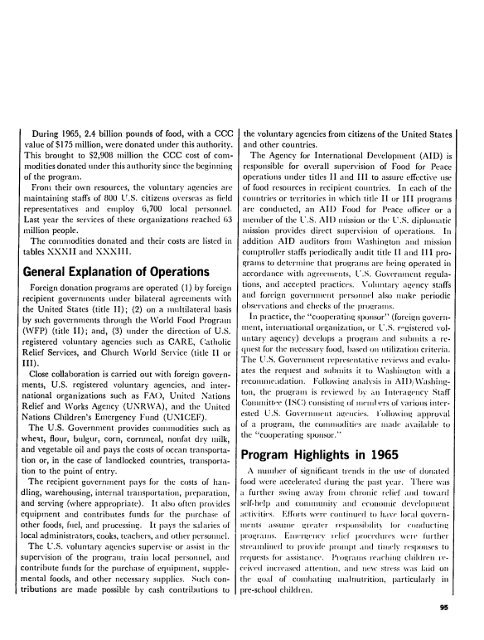foreign donations programs - PDF, 101 mb - usaid
foreign donations programs - PDF, 101 mb - usaid
foreign donations programs - PDF, 101 mb - usaid
You also want an ePaper? Increase the reach of your titles
YUMPU automatically turns print PDFs into web optimized ePapers that Google loves.
During 1965, 2.4 billion pounds of food, with a CCC<br />
value of $175 million, were donated under this authority,<br />
This brought to $2,908 million the CCC cost of corn-<br />
modities donated under this authority since the beginning<br />
of the program.<br />
From their own resources, the voluntary agencies are<br />
maintaining staffs of 800 U.S. citizens overseas as field<br />
representatives and employ 6,700 local personnel.<br />
Last year the services of these organizations reached 63<br />
million people.<br />
The commodities donated and their costs are listed in<br />
tables XXXII and XXXIII.<br />
General Explanation of Operations<br />
Foreign donation <strong>programs</strong> are operated (1) by <strong>foreign</strong><br />
recipient governments under bilateral agreements with<br />
the United States (title II); (2) on a multilateral basis<br />
by such governments through the World Food Programi<br />
(WFP) (title II); and, (3) under the direction of U.S.<br />
registered voluntary agencies such as CARE, Catholic<br />
Relief Services, and Church World Service (title II or<br />
III).<br />
Close collaboration is carried out with <strong>foreign</strong> governments,<br />
U.S. registered voluntary agencies, and international<br />
organizations such as FAO, United Nations<br />
Relief and Works Agency (UNRWA), and the United<br />
Nations Children's Emergency Fund (UNICEF).<br />
The U.S. Government provides commodities such as<br />
wheat, flour, bulgur, corn, cornmeal, nonfat dry milk,<br />
and vegetable oil and pays the costs of ocean transportation<br />
or, in the case of landlocked countries, transportation<br />
to the point of entry.<br />
The recipient government pays for the costs of handling,<br />
warehousing, internal transportation, preparation,<br />
and serving (where appropriate). It also often provides<br />
equipment and contributes funds for the purchase of<br />
other foods, ftiel, and processing. It pays the salaries of<br />
local administrators, cooks, teachers, and other personnel.<br />
The U.S. voluntary agencies supervise or assist in the<br />
supervision of the program, train local personnel, anl(<br />
contribute funds for the purchase of eqipliment, supplemental<br />
foods, and other necessary supplies. Such contributions<br />
are made possible by cash contributions to<br />
the voluntary agencies from citizens of the United States<br />
and other countries.<br />
The Agency for International Development (AID) is<br />
responsible for overall supervision of Food for Peace<br />
operations under titles I and III to assure effective use<br />
of food resources in recipient countries. In each of the<br />
countries or territories in which title II or III prograins<br />
are conducted, an All) Food for Peace officer or a<br />
me<strong>mb</strong>er of the U.S. All) mission or the U.S. diplomatic<br />
mission provides direct supervision of operations. In<br />
addition AID auditors from Washington and mission<br />
comptroller staffs periodically audit title II and II I prograis<br />
to determine that <strong>programs</strong> are being operated in<br />
accordance with agreements, 'S. Government regulations,<br />
and accepted practicvs. 'olmntary agency staffs<br />
and <strong>foreign</strong> government persomiml also make periodic<br />
observations and checks of the pot!ramns.<br />
In practice, the "cooperating sponsor" (<strong>foreign</strong> government,<br />
international organization, or U.S. r-gistered volintary<br />
agency) develops a programi and submits a request<br />
for the necessary food, based on uttilization criteria.<br />
The U.S. Government representative reviews and evaluates<br />
the request and subimits it to Washington with a<br />
reconimmendation. Following! analysis in All) \Vashin g<br />
ton, the prograi is reviewed by au Int'ragencv Staff<br />
Commiittoe (ISC) consistinq of m'mciil ers of various interested<br />
U.S. Goverm eint agenicles. l'ollowing approval<br />
of a program, the commodities are Imiade available to<br />
the 'cooperating sponsor."<br />
Program Highlights in 1965<br />
A nu<strong>mb</strong>er of significant trends in the use of donated<br />
food were accelerated during the past year-. There was<br />
at further swing away firom chronic relief and toward<br />
self-help and conmunity and econolmic d(evelo)pmiieit<br />
activitims. Effiorts were coltiu'd to haive' local governilicmits<br />
asstuli grelater reSjionsililit lr eii(tlictint<br />
)roqlills. Emlergencv mlicf procedilors wewe Iurther<br />
stmamilined to provide prompt adid tiii ely responses to<br />
rquests for assistance. l')ogra is reatchin g children r <br />
ceiv'd increased attentiom, and ne(w stress was laid on<br />
the qoal of co<strong>mb</strong>atingimalnutrition, particularly in<br />
pre-school children.<br />
95

















